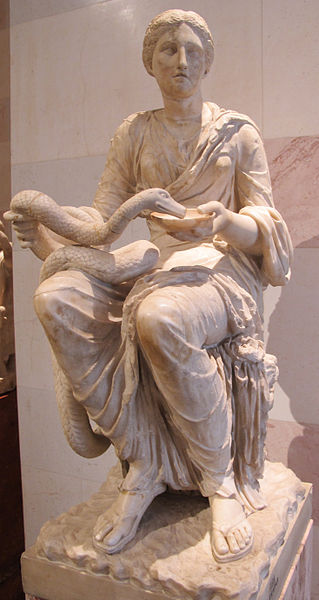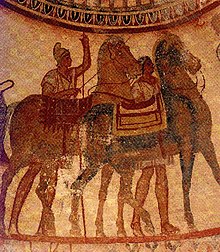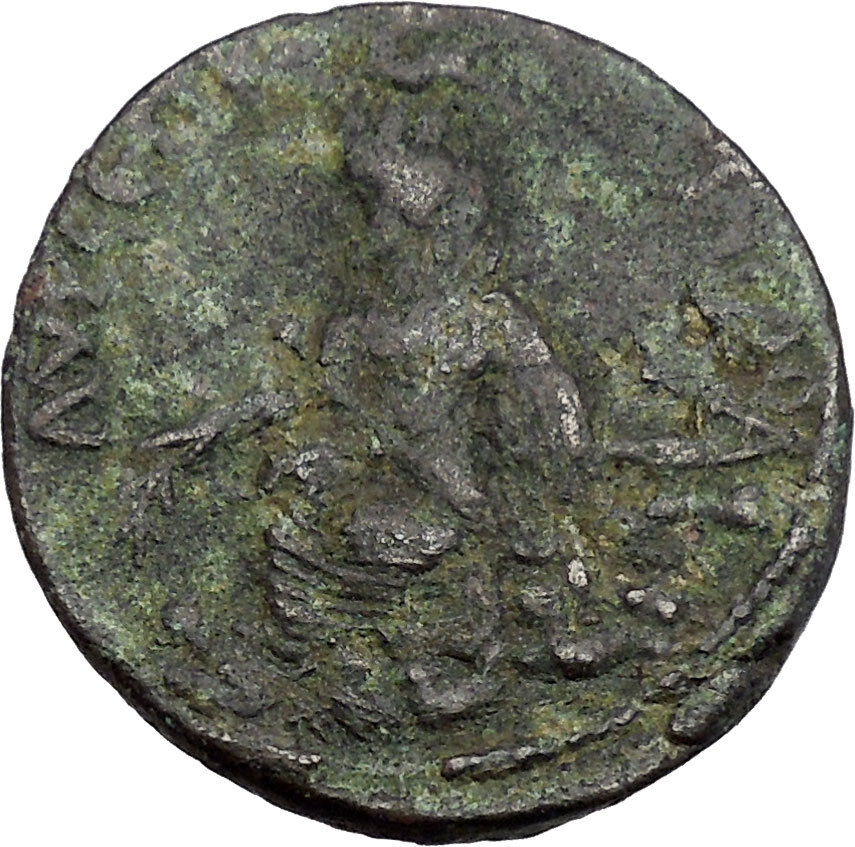|
Faustina II –
Roman Empress
& Wife of
Emperor
Marcus Aurelius
–
161-175 A.D. –
Bronze 21mm (5.92 grams) Struck in the city of Pautalia 161 A.D. in the province of Thrace
Reference: Moushmov 4115 var
ΦAVCTEINA CEBACTH, draped bust right
OVΛΠIAC ΠAVTAΛIAC, Hygeia standing right feeding serpent
she is holding.
You
are bidding on the exact item pictured, provided with a
Certificate of Authenticity and Lifetime Guarantee of
Authenticity.
In
Greek
and
Roman mythology
,
Hygieia (also Hygiea or Hygeia, Greek
Ὑγιεία or
Ὑγεία, Latin
Hygēa or Hygīa), was the daughter of the god
of medicine,
Asclepius
, and
Epione
. She was the
goddess/personification of health, cleanliness and
sanitation.

Hygieia
and her five sisters each performed a facet of
Apollo
‘s art: Hygieia
(“Hygiene” the goddess/personification of health,
cleanliness, and sanitation),
Panacea
(the goddess of
Universal remedy),
Iaso
(the goddess of
recuperation from illness),
Aceso
(the goddess of
the healing process).
Hygieia also played an important part in her father’s
cult
. While her father
was more directly associated with healing, she was
associated with the prevention of sickness and the
continuation of good health. Her name is the source of
the word “hygiene“.
She was imported by the Romans as the Goddess Valetudo,
the goddess of personal health, but in time she started
to be increasingly identified with the ancient Italian
goddess of social welfare,
Salus
.
History
At Athens, Hygieia was the subject of a local cult
since at least the 7th century BC. “Athena Hygieia” was
one of the cult titles given to
Athena
, as Plutarch
recounts of the building of the
Parthenon
(447-432 BC):
|
“ |
A strange accident happened in the course of
building, which showed that the goddess was not
averse to the work, but was aiding and
co-operating to bring it to perfection. One of
the artificers, the quickest and the handiest
workman among them all, with a slip of his foot
fell down from a great height, and lay in a
miserable condition, the physicians having no
hope of his recovery. When Pericles was in
distress about this, the goddess [Athena]
appeared to him at night in a dream, and ordered
a course of treatment, which he applied, and in
a short time and with great ease cured the man.
And upon this occasion it was that he set up a
brass statue of Athena Hygieia, in the citadel
near the altar, which they say was there before.
But it was
Phidias
who
wrought the goddess’s image in gold, and he has
his name inscribed on the pedestal as the
workman of it. |
” |
However, the cult of Hygieia as an independent
goddess did not begin to spread out until the
Delphic oracle
recognized her, and after the devastating
Plague of Athens
(430-427 BC) and in Rome in 293 BC.
In the 2nd century AD,
Pausanias
noted the
statues both of Hygieia and of Athena Hygieia near the
entrance to the
Acropolis
of Athens.
Worship
Hygieia’s primary temples were in
Epidaurus
,
Corinth
,
Cos
and
Pergamon
.
Pausanias
remarked
that, at the Asclepieion of
Titane
in
Sicyon
(founded by
Alexanor
, Asclepius’
grandson), statues of Hygieia were covered by women’s
hair and pieces of
Babylonian
clothes.
According to inscriptions, the same sacrifices were
offered at
Paros
.
Ariphron
, a Sicyonian
artist from the 4th century BC wrote a well-known
hymn
celebrating her.
Statues of Hygieia were created by
Scopas
,
Bryaxis
and
Timotheus
, among
others, but there is no clear description of what they
looked like. She was often depicted as a young woman
feeding a large snake that was wrapped around her body
or drinking from a jar that she carried. These
attributes were later adopted by the
Gallo-Roman
healing
goddess,
Sirona
. Hygieia was
accompanied by her brother,
Telesphorus
.
The
Pythagoreans
called the pentagram ὑγιεία Hugieia (“health”);
also the Greek goddess of health,
Hygieia
and saw in the pentagram a mathematical perfection.
In
Greek
and
Roman mythology
, Hygieia,
or Hygeia, was a daughter
of the god of medicine,
Asclepius
.
She was the goddess of health, cleanliness and sanitation and afterwards, the
moon. She also played an important part in her father’s
cult
. While her father was more directly associated with healing, she was associated with healing, she was
associated with the prevention of sickness and the continuation of good health.
Her name is the source of the word “hygiene“.
//
At Athens, Hygieia was the subject of a local cult since at least the
7th
century BC
. “Athena Hygieia” was one of the cult titles given to
Athena
, as
Plutarch recounts of the building of the
Parthenon
(447-432 BC):
However, the cult of Hygieia as an independent goddess did not begin to
spread out until the
Delphic oracle
recognized her, and after the devastating
Plague of Athens
(430-27 BC) and in Rome in 293 BC.
In the second century AD,
Pausanias
noted the statues both of Hygieia and of Athena Hygieia near the
entrance to the
Acropolis
of Athens.
Hygieia’s primary temples were in
Epidaurus
,
Corinth
, Cos
and
Pergamon
.
Pausanias
remarked that, at the Asclepieion of
Titane
in
Sicyon
(founded
by Alexanor
,
Asclepius’ grandson), statues of Hygieia were covered by women’s hair and pieces
of Babylonian
clothes. According to inscriptions, the same sacrifices were offered at
Paros
.
Ariphron
,
a Sicyonian artist from the
4th
century BC
wrote a well-known
hymn celebrating
her. Statues of Hygieia were created by
Scopas
,
Bryaxis
and
Timotheus
,
among others, but there is no clear description of what they looked like. She
was often depicted as a young woman feeding a large snake that was wrapped
around her body or drinking from a jar that she carried.
These attributes were later adopted by the
Gallo-Roman
healing goddess,
Sirona
. Hygieia
was accompanied by her brother,
Telesphorus
.
“Hygieia” was used as a greeting among the
Pythagoreans
.
Kyustendil (Bulgarian:
Кюстендил, historically
Велбъжд, Velbazhd) is a town in the
far west of Bulgaria
, the capital of
Kyustendil Province
, with a population of 58,059 (2005 census). Kyustendil
is situated in the southern part of the Kyustendil Valley, 90 km southwest of
Sofia
. It was
named after the medieval lord of the surrounding region,
Constantine Dragaš
.
A Thracian
settlement was founded at the place of the modern town in the
5th
-4th
century BC and the
Romans
developed it into an important stronghold, balneological resort and trade
junction called Pautalia in the 1st century AD.
The Hisarlaka fortress was built in the 4th century and the town was
mentioned under the
Slavic
name of Velbazhd (Велбъжд, meaning “camel”)[1]
in a 1019 charter by the
Byzantine
Emperor
Basil II
.
It became a major religious and administrative centre.
Annia
Galeria Faustina Minor (Minor Latin for
the younger), Faustina Minor or Faustina
the Younger

(February
16 between 125 and 130-175) was a daughter of
Roman Emperor
Antoninus Pius
and Roman Empress
Faustina the Elder
. She was a Roman Empress and wife
to her maternal cousin Roman Emperor
Marcus Aurelius
. Though Roman sources give a
generally negative view of her character, she was held
in high esteem by soldiers and her own husband and was
given divine honours after her death.
//
Biography
Faustina, named after her mother, was
her parents’ fourth and youngest child and their second
daughter; she was also their only child to survive to
adulthood. She was born and raised in
Rome
.
Her great uncle, the Emperor
Hadrian
, had arranged with her father for Faustina
to marry
Lucius Verus
. On February 25, 138, she and Verus
were betrothed.
Verus’ father
was Hadrian’s first adopted son and
his intended heir. However when Verus’ father died,
Hadrian chose Faustina’s father to be his second adopted
son, and eventually, he became Hadrian’s successor.
Faustina’s father ended the engagement between his
daughter and Verus and arranged for Faustina’s betrothal
to her maternal cousin,
Marcus Aurelius
; Aurelius was also adopted by her
father. On May 13, 145, Faustina and Marcus Aurelius
were married. When her father died on March 7, 161, her
husband and Lucius Verus succeeded to her father’s
throne and became co-rulers. Faustina was given the
title of
Augusta
and became Empress.
Unfortunately, not much has survived
from the Roman sources regarding Faustina’s life, but
what is available does not give a good report.
Cassius Dio
and the
Augustan History
accuse Faustina of ordering
deaths by poison and execution; she has also been
accused of instigating the revolt of
Avidius Cassius
against her husband. The Augustan
History mentions adultery with sailors, gladiators,
and men of rank. However, Faustina and Aurelius seem to
have been very close and mutually devoted. Her husband
trusted her and defended her vigorously against
detractors.
Faustina accompanied her husband on
various military campaigns and enjoyed the love and
reverence of Roman soldiers. Aurelius gave her the title
of Mater Castrorum or Mother of the Camp.
Between 170-174, she was in the north, and in 175, she
accompanied Aurelius to the east. However, these
experiences took their toll on Faustina, who died in the
winter of 175, after an accident, at the military camp
in Halala (a city in the
Taurus Mountains
in
Cappadocia
).
Aurelius grieved much for his wife
and buried her in the Mausoleum of Hadrian in Rome. She
was deified: her statue was placed in the Temple of
Venus in Rome and a temple was dedicated to her in her
honor. Halala’s name was changed to Faustinopolis
and Aurelius opened charity schools for orphan girls
called Puellae Faustinianae or ‘Girls of
Faustina’.[1]
The Baths of Faustina in
Miletus
are named after her.
In their thirty years of marriage,
Faustina bore Marcus Aurelius thirteen children:
-
Annia Aurelia Galeria Faustina
(147-after 165)
-
Gemellus Lucillae (died around
150), twin brother of Lucilla
-
Annia Aurelia Galeria
Lucilla
(148/50-182), twin sister of Gemellus,
married her father’s co-ruler
Lucius Verus
-
Titus Aelius Antoninus (born
after 150, died before 7 March 161)
-
Titus Aelius Aurelius (born after
150, died before 7 March 161)
-
Hadrianus (152-157)
-
Domitia Faustina (born after 150,
died before 7 March 161)
-
Fadilla
(159-after 211)
-
Annia Cornificia Faustina Minor
(160-after 211)
-
Titus Aurelius Fulvus Antoninus
(161-165), twin brother of Commodus
-
Commodus
(161-192), twin brother of Titus
Aurelius Fulvus Antoninus, later emperor
-
Marcus Annius Verus Caesar
(162-169)
- Vibia Aurelia Sabina (170-died before 217)
Thrace is a historical and geographic
area in southeast
Europe
. As a
geographical concept, Thrace designates a region bounded
by the
Balkan Mountains
on the
north,
Rhodope Mountains
and
the
Aegean Sea
on the
south, and by the
Black Sea
and the
Sea of Marmara
on the
east. The areas it comprises are southeastern
Bulgaria
(Northern
Thrace), northeastern
Greece
(Western
Thrace), and the European part of
Turkey
(Eastern
Thrace). The biggest part of Thrace is part
of present-day Bulgaria. In Turkey, it is also called
Rumelia
. The name comes
from the
Thracians
, an ancient
Indo-European
people
inhabiting Southeastern Europe.
The historical boundaries of Thrace have varied.
Noteworthy is the fact that, at an early date, the
ancient Greeks
employed
the term “Thrace” to refer to all of the territory which
lay north of
Thessaly
inhabited by
the
Thracians
,[1]
a region which “had no definite boundaries” and to which
other regions (like
Macedonia
and even
Scythia
) were added.[2]
In one ancient Greek source, the very Earth is divided
into “Asia, Libya, Europa and Thracia”.[2]
As the knowledge of world geography of the Greeks
broadened, the term came to be more restricted in its
application: Thrace designated the lands bordered by the
Danube
on the north, by
the Euxine Sea (Black Sea) on the east, by northern
Macedonia
in the south
and by the
Illyrian
lands (i.e.
Illyria
) to the west.[2]
This largely coincided with the Thracian
Odrysian kingdom
, whose
borders varied in time. During this time, specifically
after the Macedonian conquest, the region’s old border
with Macedonia was shifted from the
Struma River
to the
Mesta River
.[3][4]
This usage lasted until the Roman conquest. Henceforth,
(classical) Thrace referred only to the tract of land
largely covering the same extent of space as the modern
geographical region. In its early period, the
Roman province of Thrace
was of this extent, but after the administrative reforms
of the late 3rd century, Thracia’s much reduced
territory became the six small provinces which
constituted the
Diocese of Thrace
. The
medieval
Byzantine
theme
of
Thrace
contained only
what today is
Eastern Thrace
.
The largest cities of Thrace are:
İstanbul
(European
side),
Plovdiv
,
Burgas
,
Stara Zagora
,
Haskovo
,
Edirne
,
Çorlu
and
Tekirdag
.
Most of the Bulgarian and Greek population are
Christians, while most of the Turkish inhabitants of
Thrace are Muslims.
Thrace in ancient Greek mythology
Ancient Greek mythology
provides them with a mythical ancestor, named
Thrax
, son of the
war-god
Ares
, who was said to
reside in Thrace. The Thracians appear in
Homer
‘s
Iliad
as
Trojan
allies, led by
Acamas
and
Peiros
. Later in the
Iliad,
Rhesus
, another
Thracian king, makes an appearance.
Cisseus
, father-in-law
to the Trojan elder
Antenor
, is also given
as a Thracian king. Homeric Thrace was vaguely defined,
and stretched from the River
Axios
in the west to
the
Hellespont
and
Black Sea
in the east.
The
Catalogue of Ships
mentions three separate contingents from Thrace:
Thracians led by Acamas and Peiros, from
Aenus
;
Cicones
led by
Euphemus
, from southern
Thrace, near
Ismaros
; and from the
city of
Sestus
, on the Thracian
(northern) side of the Hellespont, which formed part of
the contingent led by
Asius
. Greek mythology
is replete with Thracian kings, including
Diomedes
,
Tereus
,
Lycurgus
,
Phineus
,
Tegyrius
,
Eumolpus
,
Polymnestor
,
Poltys
, and
Oeagrus
(father of
Orpheus
). In addition
to the tribe that Homer calls Thracians, ancient Thrace
was home to numerous other tribes, such as the
Edones
,
Bisaltae
,
Cicones
, and
Bistones
.
Thrace is also mentioned in Ovid’s Metamorphoses in
the episode of
Philomela
, Procne, and
Tereus
. Tereus, the
King of Thrace, lusts after his sister-in-law, Philomela.
He kidnaps her, holds her captive, rapes her, and cuts
out her tongue. Philomela manages to get free, however.
She and her sister, Procne, plot to get revenge, by
killing Itys (son of Tereus and Procne) and serving him
to his father for dinner. At the end of the myth, all
three turn into birds—Procne, a swallow; Philomela, a
nightingale; and Tereus, a
hoopoe
.
History
Ancient history

Thracian Tomb of
Kazanlak
The indigenous population of Thrace was a people
called the
Thracians
, divided into
numerous tribal groups. Thracian troops were known to
accompany neighboring ruler
Alexander the Great
when he crossed the
Hellespont
which abuts
Thrace, and took on the
Persian Empire
of the
day.
The Thracians did not describe themselves as such and
Thrace and Thracians are simply the names
given them by the Greeks.[5]
Divided into separate tribes, the Thracians did not
manage to form a lasting political organization until
the
Odrysian state
was
founded in the 4th century BC. Like
Illyrians
, Thracian
tribes of the mountainous regions fostered a locally
ruled warrior tradition, while the tribes based in the
plains were purportedly more peaceable. Recently
discovered funeral mounds in Bulgaria suggest that
Thracian kings did rule regions of Thrace with distinct
Thracian national identity.
During this period, a subculture of
celibate
ascetics
called the
Ctistae
lived in
Thrace, where they served as philosophers, priests and
prophets.
Medieval history
By the mid 5th century, as the Roman Empire began to
crumble, Thracia fell from the authority of Rome and
into the hands of Germanic tribal rulers. With the fall
of Rome, Thracia turned into a battleground territory
for the better part of the next 1,000 years. The eastern
successor of the
Roman Empire
in the
Balkans, the
Byzantine Empire
,
retained control over Thrace until the 8th century when
the northern half of the entire region was incorporated
into the
First Bulgarian Empire
.
Byzantium regained Thrace in the late 10th century and
administered it as a
theme
, until the
Bulgarians regained control of the northern half at the
end of the 12th century. Throughout the 13th century and
the first half of the 14th century, the region was
changing in the hands of the Bulgarian and the Byzantine
Empire(excl. Constantinopole). In 1265 the area suffered
a Mongol raid from the
Golden Horde
, led by
Nogai Khan
. In 1352,
the
Ottoman
Turks
conducted their
first incursion into the region subduing it completely
within a matter of two decades and occupying it for five
centuries.
Modern
history
With the
Congress of Berlin
in
1878, Northern Thrace was incorporated into the
semi-autonomous Ottoman province of
Eastern Rumelia
, which
united with Bulgaria in 1885. The rest of Thrace was
divided among Bulgaria, Greece and Turkey at the
beginning of the 20th century, following the
Balkan Wars
,
World War I
and the
Greco-Turkish War
.
Today Thracian is a strong regional identity in
Greece, Turkey, Bulgaria and other neighbouring
countries.
Famous Thracians and people from Thrace
- A number of
Roman emperors
of
the 3rd-5th century were of
Thraco-Roman
backgrounds (Maximinus
Thrax,
Licinius
,
Galerius
,
Aureolus
,
Leo the Thracian
,
etc.). These emperors were elevated via a military
career, from the condition of common soldiers in one
of the
Roman legions
to
the foremost positions of
political power
.
|






 associated with healing, she was
associated with healing, she was 




